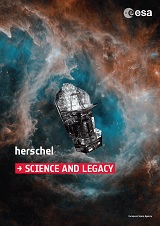ESA Science & Technology - Publication Archive
Publication archive
Publication archive
This brochure summarises the Herschel mission and its science achievements to date, capturing the basis for the science yet to come and its enduring legacy.
The European Space Agency's Herschel Space Observatory flew the largest single mirror ever built for a space telescope. At 3.5-metres in diameter the mirror collected long-wavelength radiation from some of the coldest and most distant objects in the Universe. In addition, Herschel was the only space observatory to cover a spectral range from the far infrared to sub-millimetre.
The Herschel mission leaves behind a lasting legacy in the form of a treasure trove of data, thousands of scientific papers, and a new generation of astronomers whose professional lives have been formed by working on this remarkable endeavour.
Contents:
- Foreword
- The other half of the light
- Tools of the trade
- The Herschel mission
- Gathering the light
- The infrared Universe
- Origins
- Engines of star formation
- From dust to planets
- The water trail
- An international enterprise
- A lasting legacy
Aims. We present the first public release of high-quality data products (DR1) from Hi-GAL, the Herschel infrared Galactic Plane Survey. Hi-GAL is the keystone of a suite of continuum Galactic plane surveys from the near-IR to the radio and covers five wavebands at 70, 160, 250, 350 and 500μm, encompassing the peak of the spectral energy distribution of cold dust for 8 ≤ T ≤50K. This first Hi-GAL data release covers the inner Milky Way in the longitude range 68°≥ l ≥ -70° in a |b| ≤ 1° latitude strip.
Methods. Photometric maps have been produced with the ROMAGAL pipeline, which optimally capitalizes on the excellent sensitivity and stability of the bolometer arrays of the Herschel PACS and SPIRE photometric cameras. It delivers images of exquisite quality and dynamical range, absolutely calibrated with Planck and IRAS, and recovers extended emission at all wavelengths and all spatial scales, from the point-spread function to the size of an entire 2°×2° "tile" that is the unit observing block of the survey. The compact source catalogues were generated with the CuTEx algorithm, which was specifically developed to optimise source detection and extraction in the extreme conditions of intense and spatially varying background that are found in the Galactic plane in the thermal infrared.
Results. Hi-GAL DR1 images are cirrus noise limited and reach the 1σ-rms predicted by the Herschel Time Estimators for parallel mode observations at 60" s-1 scanning speed in relatively low cirrus emission regions. Hi-GAL DR1 images will be accessible through a dedicated web-based image cutout service.
[Remainder of abstract truncated due to character limitations]
[Remainder of abstract truncated due to character limitations]
The nature and origin of the cold interstellar medium (ISM) in early-type galaxies are still a matter of debate, and understanding the role of this component in galaxy evolution and in fuelling the central supermassive black holes requires more observational constraints. Here, we present a multiwavelength study of the ISM in eight nearby, X-ray and optically bright, giant elliptical galaxies, all central dominant members of relatively low-mass groups. Using far-infrared spectral imaging with the Herschel Photodetector Array Camera & Spectrometer, we map the emission of cold gas in the cooling lines of [C II] 157 μm, [O I] 63 μm and [O Ib] 145 μm. Additionally, we present H-alpha+[N II] imaging of warm ionized gas with the Southern Astrophysical Research (SOAR) telescope, and a study of the thermodynamic structure of the hot X-ray emitting plasma with Chandra. All systems with extended H-alpha emission in our sample (6/8 galaxies) display significant [C II] line emission indicating the presence of reservoirs of cold gas. This emission is cospatial with the optical H-alpha+[N II] emitting nebulae and the lowest entropy soft X-ray emitting plasma. The entropy profiles of the hot galactic atmospheres show a clear dichotomy, with the systems displaying extended emission-line nebulae having lower entropies beyond r >= 1 kpc than the cold-gas-poor systems. We show that while the hot atmospheres of the cold-gas-poor galaxies are thermally stable outside of their innermost cores, the atmospheres of the cold-gas-rich systems are prone to cooling instabilities. This provides considerable weight to the argument that cold gas in giant ellipticals is produced chiefly by cooling from the hot phase. We show that cooling instabilities may develop more easily in rotating systems and discuss an alternative condition for thermal instability for this case.
[Remainder of abstract truncated due to character limitations]

